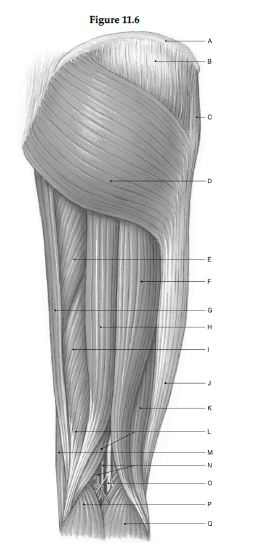Using the figure below, identify the labeled part.

1) Label A: ______________________________
2) Label B: ______________________________
3) Label C: ______________________________
4) Label D: ______________________________
5) Label E: ______________________________
6) Label F: ______________________________
7) Label G: ______________________________
8) Label H: ______________________________
9) Label I: ______________________________
10) Label J: ______________________________
11) Label K: ______________________________
12) Label L: ______________________________
13) Label M: ______________________________
14) Label N: ______________________________
15) Label O: ______________________________
16) Label P: ______________________________
17) Label Q: ______________________________
1) Iliac crest
2) Gluteal aponeurosis over gluteus medius
3) Tensor fasciae latae
4) Gluteus maximus
5) Adductor magnus
6) Biceps femoris, long head
7) Gracilis
8) Semitendinosus
9) Semimembranosus
10) Iliotibial tract
11) Biceps femoris, short head
12) Semimembranosus
13) Sartorius
14) Popliteal artery and vein
15) Tibial nerve
16) Medial head of gastrocnemius
17) Lateral head of gastrocnemius
You might also like to view...
Lymphatic capillaries are also called __________ lymphatics.
Fill in the blank(s) with the appropriate word(s).
Since neurons are not usually replaced after they are destroyed or die, the brain lacks plasticity of functions
Indicate whether the statement is true or false
Insulin is produced by:
a. Alpha cells in the pancreatic isles b. Chief cells in the stomach c. Beta cells in the pancreatic islets d. Alpha cells in the adrenal medulla e. Parafollicular cells in the thyroid gland
Which of the following is NOT an anabolic effect of testosterone?
A) Testosterone increases the number of erythrocytes. B) Testosterone increases bone density. C) Testosterone increases skeletal muscle mass. D) Testosterone increases libido.